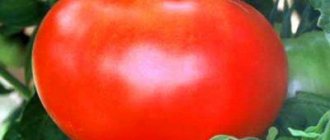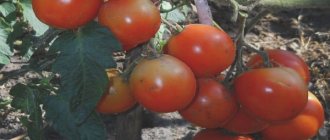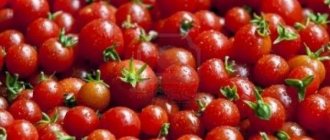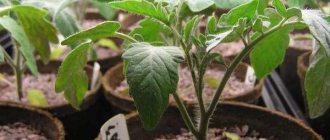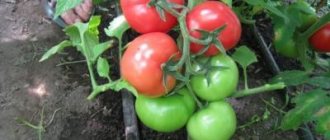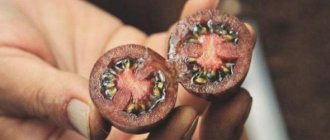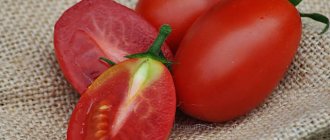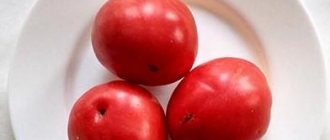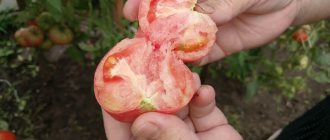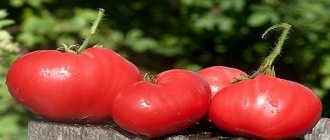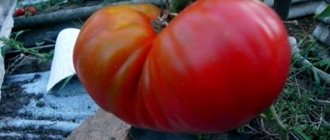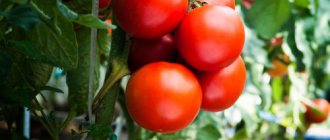Every spring, many thousands of summer residents rush from cities to their country houses to try to grow and harvest a rich harvest of vegetables, fruits and berries over the summer. Some will be used immediately, some will be salted for the winter, and the excess can be sold to your benefit. Therefore, experienced summer residents approach each new variety with a certain degree of doubt: will it be able to provide a rich harvest with proper care? It is not surprising that the Favorite tomato variety is of particular interest to many who like to work on the land. Therefore, we will tell you about it in more detail.
Description
The Fluffy tomato is suitable for growing both in greenhouse conditions and in open ground. The bushes grow quite compact and bear fruit well over a long period of time.
Bushes
Plants can reach 70-90 centimeters in height, depending on growing conditions. Usually bushes are formed from 3-4 stems.
Upon closer inspection, you will notice that all the stems of the bush are covered with small fibers. On a strong stem there are large green leaves in moderate quantities. The leaf length reaches 25 centimeters.
Inflorescences can be of 2 types: simple and semi-complex.
Fruit
There are 2 types of Fluffy tomatoes
- Pink. The fruits of this species are round in shape, pink in color, and have a silvery fluff on the surface.
- Red. The fruits are red in color and mostly round in shape.
Fruit ripening occurs 3 months after the seedling appears. The pulp of tomatoes is juicy, soft, pink in color, and has a pleasant aroma. The fruit tastes sweet, with a slight sourness. The weight of tomatoes is approximately 70 g.
Productivity
Comparing pink and red types of Fluffy tomato, it can be noted that pink has the highest yield. On average, 20 kilograms of tomatoes are obtained from one square meter. Red Fluffy is capable of producing slightly less fruit - 15 kilograms per square meter. On average, from one bush you can get about 4-5 kg of ripe tomatoes per season.
Characterizing “Favorite”
The tomato will demonstrate optimal results by forming an indeterminate bush with a single stem, which requires tying to a support or trellis. Fruit ripening times are average - from planting seeds to seedlings to harvesting tomatoes, it will take from 107 to 120 days.
The bushes are distinguished by a good number of gray-green leaves of medium size and a slight degree of corrugation and simple and compact inflorescences with three to four fruits on each. The formation of the latter occurs after the 7th leaf and then every three. The best density for planting is the presence of 2-3 plants per square meter. In terms of yield, about two dozen kilograms of tomatoes are harvested from one square meter and about 6-7 kg from a bush.
Characteristics and description of the Favorite tomato variety
Among the variety of tomato varieties, it can be very difficult to choose just one that would fully meet all the gardener’s requirements. Tomato Favorita F1 is one of those varieties of nightshade crops that are distinguished by good yield and high taste of ripe vegetables. Those gardeners who grew this hybrid were completely satisfied with it.
Advantages and disadvantages of tomatoes
Reviews from gardeners and gardeners who cultivated crops in their summer cottages were generally satisfied with the results obtained. But, like any other hybrid, the Favorite tomato has not only advantages, but also a number of disadvantages.
Description of advantages:
- The fruits are quite large in size;
- Stable harvest throughout the entire fruiting period;
- Resistance to many “tomato” diseases;
- Seedlings can be planted in the shade;
- Universal use in cooking;
- Good appearance of tomatoes, suitable for sale;
- Pleasant taste of ripe tomatoes.
Description of disadvantages:
- Tomatoes are not stored for a long time and are not suitable for long-term transportation;
- Due to the very thin skin, the fruits cannot be preserved in their entirety;
- The bushes need to be tied to a support.
Many gardeners believe that to get a rich harvest, it is enough to plant seedlings and periodically water the bushes. This opinion is completely wrong.
Even if with minimal effort the harvest is stable, the quality of the fruit may not be as good. Some produce sweet fruits only when mineral and organic fertilizers are applied.
The future harvest must be treated very carefully.
Features of growing and caring for the Favorit hybrid are no different from cultivating other varieties, and even cherry tomatoes.
Young seedlings are planted in the soil after the weather has become warm outside. In most regions, this is the last days of May, or the beginning of June. If you plant seedlings in bad weather, they will often get sick and also grow very slowly.
Every year the place where seedlings are grown should be changed. This is necessary so that the earth has time to recover and be saturated with microelements.
It is not advisable to choose for planting areas where potatoes, eggplants or bell peppers previously grew. Firstly, all these crops feed on the same substances. And secondly, tomatoes can become infected with late blight from these vegetables.
About the rules for growing and caring for “Favorite”
There is an opinion that you can get a good number of fruits only by planting seedlings and watering them from time to time. In fact, in this case, you can get a stable harvest, but the fruits will lose quality content. Thus, a sweet taste is often obtained only by feeding with mineral and organic fertilizers. Therefore, caring for the crop must be careful.
In general, the rules for growing and caring for the Favorit hybrid are no different from the cultivation of other tomatoes, including Cherry tomatoes.
- Young seedlings should be planted after a stable warm temperature outside the window. In most Russian regions this is at the end of May or beginning of June. When planted in unfavorable conditions, the seedlings will be weak, sickly and will not develop quickly.
- The area for cultivating seedlings must be changed annually. This is important for restoring the earth and saturating it with vital elements.
- For tomatoes, you should not make a choice in favor of the place where eggplants, bell peppers or potatoes were previously grown for reasons of feeding with the same set of substances and the possibility of tomato infection with late blight.
Characteristics
The fruits of this hybrid set light green and become a beautiful yellow-orange color when ripe. In size - medium, weighing up to 200 grams, usually 120-150g. The tomatoes look very aesthetically pleasing, on the bush they are collected in dense clusters and ripen together. On the rounded, smoothed fruit, ribs are visible that separate 4 chambers with seeds. The fruit is dense. It stores well and is not prone to cracking with changes in temperature and humidity.
The table below will help you compare the weight of the fruits of the Golden Mother-in-law variety with others:
| Variety name | Fruit weight |
| Golden mother-in-law | 120-150 grams |
| Miracle Lazy | 60-65 grams |
| Sanka | 80-150 grams |
| Lyana Pink | 80-100 grams |
| Shchelkovsky Early | 40-60 grams |
| Labrador | 80-150 grams |
| Severenok F1 | 100-150 grams |
| Bullfinch | 130-150 grams |
| Room surprise | 25 grams |
| F1 debut | 180-250 grams |
| Alenka | 200-250 grams |
In open ground, up to 2.5 kg of fruit can be collected from one bush; in a greenhouse, the yield is higher - up to 4 kg. The hybrid breeder speaks of “Golden Mother-in-Law” as a universal variety, suitable for both fresh consumption and canning, processing into juice or tomato paste. And if only convinced aesthetes are ready to make paste from yellow fruits, then these golden, slightly sour tomatoes are very good in a salad. The dense skin prevents the fruit from cracking even during preservation.
Yield indicators for other varieties can be found below:
| Variety name | Productivity |
| Golden mother-in-law | 2.5-4 kg per bush |
| Raspberry ringing | 18 kg per square meter |
| Red Arrow | 27 kg per square meter |
| Valentina | 10-12 kg per square meter |
| Samara | 11-13 kg per square meter |
| Tanya | 4.5-5 kg per bush |
| f1 favorite | 19-20 kg per square meter |
| Demidov | 1.5-5 kg per square meter |
| Beauty King | 5.5-7 kg per bush |
| Banana Orange | 8-9 kg per square meter |
| Mystery | 20-22 kg per bush |
Chernomor
Chernomor is an unusual variety. Ripe fruits are dark in color, which looks purple or burgundy from different angles. Tomatoes have an unusual appearance and taste.
The fruits ripen in 4 months. The height of the bush is 150 cm. Heavy fruits form on the branches, so the bush needs to be tied up, preferably in several places. It is not necessary to fix every centimeter, but the fruit clusters must be tied to a vertical support. The weight of a ripe tomato is 0.3 kg. The fruits after ripening are juicy, with a slight sourness.
Features of care
Light soils rich in nutrients are suitable for growing Chernomor. Tomatoes do not need a lot of watering. Plants are watered once a week. There is no need to rush into planting in open ground. Tomatoes of the Chernomor variety do not tolerate low temperatures well, so they are planted in warm soil (the first half of June).
The Chernomor hybrid is not resistant to diseases and pests - the vegetable crop should be treated.
Malachite Box
Nadya: super tasty, even my picky son appreciated it, he doesn’t eat any tomatoes at all, but he ate this one. I planted 1 bush for testing, in a greenhouse, tied it up, and pinched it. The fruit at technical maturity is yellow-green both on top and inside.
Varvara Plyushkina: the taste is sweet and sour, they picked it a little early out of interest, the next ones will need to wait longer. These were picked on the street; there were no ripe ones in the greenhouse yet.
Mirage: interesting tomatoes. Very sweet. Really very delicate, not for transportation. I really liked the taste. But my husband and daughter do not want to eat them. Visually they are not satisfied with them. And I’m also disappointed by the huge amount of tops (although I kept an eye on them, took steps), the enormous growth and, against this background, a very small number of fruits. Irandi: Malachite box - unusual in appearance, I don’t have very many fruits, but they’re tasty, I’ll plant them. In September I will go to the Urals and take them to try the “Malachite Box”.
Description of the tomato variety Goose Egg and its characteristics
Among the promising varieties, it is worth highlighting the interesting and unusual Goose Egg tomato. Tomatoes got their name from their unusual shape. It really does look a lot like a large egg.
In order to get a good harvest and avoid unnecessary hassle, you should study the characteristics and description of the Goose Egg tomato variety.
Description of the variety
Tomato “Goose Egg” is a mid-season cultivar of indeterminate type. When properly cultivated it gives a very good harvest. It begins to bear fruit 100-110 days after the first shoots.
- A tall plant can reach 1.5-2 meters in height.
- The bushes are spreading, heavily leafy.
- The fruits are formed in clusters. The cluster is complex, with an average of 6-8 fruits on each. On the upper hands the quantity may be reduced.
- The harvest is given away together. There is a great tendency to fully ripen the hand.
- Fairly high yield: up to 8 kg per 1 sq. m.
- The variety is resistant to late blight.
Fruit characteristics
Tomatoes of the “Goose Egg” variety do not need to be fully ripened on the bunch; they ripen well even after picking.
- The fruits are smooth, elastic and strong.
- The weight of tomatoes is up to 300 grams.
- The color of ripe tomatoes ranges from dark pink to bright red.
- The skin is thin, but dense, without veins. Easy to remove from ripe tomatoes.
- Resistant to cracking.
- The pulp is fleshy, few seeds and almost without liquid.
- Rich tomato aroma.
- The taste is pleasant, sweetish with piquant sourness.
- They are not prone to mechanical damage and are surprisingly well stored. They can last up to 45 days.
The qualities of the pulp allow the use of Goose Egg tomatoes in a broader aspect. They are equally good for fresh consumption, for canning and various preparations for the winter, as well as for drying and freezing.
Favorite F1
At first, the first ones seemed a little sour, but when the clusters began to ripen, the cherry tomatoes turned out to be very sweet and tasty, my daughter noticed this, and even my husband praised it...momo5000: This is the second year I’ve been planting Favorita, it’s very tasty, a little spicy, even sweet. And I will continue to plant. True, she stepson very strongly, but the storm is all the way to the top of her head.
01/20/16, selection made by Varvara Plyushkina
- Tomato diseases: the main thing is to strike back in time!
- How to get a good tomato harvest
- Horseradish
Tomato Favorite F1 is intended for growing in greenhouse conditions. The variety is mid-season; from germination to ripening you need to wait 107-120 days. The plant is indeterminate, the key feature of which is low shoot formation.
I am able, on 30% of the nodes no stepsons are formed at all, on another 30% very weak stepsons are formed, and only the remaining 40% of normal strong stepsons that will need to be removed in the process of forming the plant into one stem. Timely and correct pruning of tomato leaves can significantly increase the yield.
The leaves are medium in size, the inflorescences of the variety are simple and compact, 3-4 tomatoes on each, they begin to form after the 7th leaf, followed by every 3. During the growth process, the bush must be tied to a vertical support, as well as intensive fertilizing with mineral fertilizers. The yield of the Favorit F1 variety is 18-20 kg per square meter. Planting density is 2-3 plants per meter.
The fruits ripen on the cluster together, on average the weight of each tomato is 120 g. The fruits are red, slightly ribbed, round in shape. The tomatoes taste good.
Plant care
In general, the “Favorite” variety is not too different from other tomatoes in terms of care.
It does not like excess moisture; thin-skinned fruits may even crack because of this. Therefore, you only need to water the beds if there has been no rain for a long time.
The variety resists many diseases very well, which is important for summer residents who spend most of their time in the city - in such a situation it is not always possible to quickly respond to the threat.
But gartering the bushes is mandatory. The fruits, as already mentioned, are formed in clusters of up to six pieces. Moreover, each weighs approximately 200 grams. So, the mass of the hand reaches 1-1.2 kilograms, and in some cases more. Of course, under such weight the branches may well break. Therefore, it is advisable to tie the bushes once, and sometimes twice, per season. And this applies to both cultivation in open ground and in greenhouses.
The formation of bushes is also not superfluous. The side shoots of this variety are weak, so it is advisable to remove them immediately so that they do not draw out beneficial substances. The plant will stretch upward, thanks to which all the leaves and fruits will receive maximum sunlight and heat, which will have a positive effect on the yield and taste of the tomatoes.
Strawberry Dessert
Tomato, according to reviews from gardeners, is valued for its taste. Its growth does not stop after the formation of flower clusters. Strawberry dessert is a mid-season variety. The first fruits ripen at the beginning of July. When grown in open ground, the fruits do not fully ripen, so it is advisable to grow Strawberry dessert in a greenhouse.
The unusual shape of the tomato and its ruby color attract attention. The thin-skinned fruits are slightly flattened, their juicy pulp has a sweet taste. These tomatoes are used for preparing dressings, sauces, and salads. They are suitable for pickling and eating raw. The weight of one fruit is 0.3 kg. 11 kg of fruits are collected from one bush.
This variety bears fruit throughout the summer months. In greenhouses, the fruiting period ends at the beginning of winter. The hybrid is resistant to diseases and pests.
Features of care
The plant is planted, and when growing seedlings, the length of daylight is artificially increased. Tomato Strawberry dessert is difficult to care for. He needs weekly feeding. Bushes should not be planted close to each other. In the absence of light, the fruits will not ripen. Tomatoes develop well at a temperature of 21°C and require abundant watering.
Which is better: determinant or indeterminate?
In order to understand which tomato is best, you need to know the meaning of these words:
- Determinate is a stem with limited growth, it grows to a certain height and the last point of growth ends in the ovary. Such bushes are usually planted in open areas where there is nowhere to tie the bushes.
- Indeterminate is a stem with unlimited growth; in this case, side shoots are not formed, and branches with tomatoes appear instead of leaves. The characteristic is this: if the growth of this stem is not stopped, it will bear fruit until frost. Typically, such tomatoes are grown in greenhouses; these varieties are the most popular in industry.
- There is another low-growing species - standard, it does not require gartering, pinching or pruning of leaves. It grows in both open and closed areas. But due to the small growth, the yield is low.
Cherry
Cherry is a group of varieties that are united by the small size of their fruits. The average weight of a ripe fruit is 20 g. Tomatoes have sweet pulp. They are great for canning, especially when it comes to assorted vegetables. Cherry tomatoes fit into containers of any size, which simplifies the process.
Cherry tomato bushes can be either short or tall. There are also medium-sized species. The fruits can be red, yellow or brown. They all ripen at the same time. During harvest, a whole bunch is cut from the bush.
Features of care
To preserve the taste, the fruits must ripen
Cherry tomatoes are grown in open ground and greenhouses. Seeds are not planted in open ground.
The plant is systematically pruned, leaving 1 or 2 stems. Regardless of the height of the bush, the stem and branches are tied to a vertical base. The fruits must ripen completely on the branch of the bush, otherwise their taste will deteriorate.
Cultivation and care
The idea that to get a rich harvest it is enough to plant seedlings and water them periodically is wrong. With this approach there will never be a stable and high-quality harvest.
First you need to sow the seeds. Before planting in the ground, they are disinfected in a solution of potassium permanganate and washed under running water. Suitable containers for germinating seeds are small plastic cups or pots. Drainage is placed at the bottom of the container, soil is poured on top and warm water is poured over it. After the moisture is absorbed, small depressions are made in the soil into which the seeds are sown. Sprinkle the seeds on top with a thin layer of moist soil. The container is covered with a plastic lid and stored in a warm, illuminated place.
After the first shoots appear, hardening is carried out. Plants are placed in a cooler room.
Seedlings need regular watering and constant lighting.
Advice! You can purchase ready-made seedlings at a store specializing in gardening and vegetable gardening.
Young seedlings are planted in the soil when the air temperature outside during daylight hours reaches 18-20 degrees. Usually this is the end of May - beginning of June. Transplant seedlings in good warm weather, otherwise the plant will get sick and grow slowly.
The soil needs to be given great attention. Quality soil is half the success. The soil mixture consists of sand, compost or humus and peat with garden soil
Additionally, the soil is fertilized with potassium, superphosphate and urea
The soil mixture consists of sand, compost or humus and peat with garden soil. Additionally, the soil is fertilized with potassium, superphosphate and urea.
Important! Every year, the soil for growing tomatoes must be changed so that the soil has time to recover and be saturated with microelements. It is not recommended to plant tomatoes in place of potatoes, eggplant or peppers
Tomatoes run the risk of becoming infected with late blight from such soil.
It is not recommended to plant tomatoes in place of potatoes, eggplant or peppers. Tomatoes run the risk of becoming infected with late blight from such soil.
For active growth of tomatoes, it is necessary to maintain a constant temperature in the greenhouse of about 22-24 degrees Celsius. The greenhouse is ventilated to ensure an influx of fresh air. In hot weather there is a draft. Regular humidity in the greenhouse should be 70%. The soil is watered as it dries. Water temperature is 20-25 degrees. Each bush needs at least 500 ml of liquid.
During the appearance of flowers and ovaries, the plant needs feeding and fertilizer. Fertilizing is applied along with watering during the budding period of the plant and during the appearance of fruits. Monopotassium phosphate and potassium nitrate are added weekly to the water for irrigation.
Secret. Bees help pollinate tomatoes. You can attract them to the greenhouse with sugar syrup.
After the fruits appear, the tomatoes require a garter. The material is thin strips of fabric. The fabric must be disinfected. Pegs are driven in near the stem and the stem is tied to them.
Providing moisture to the plant as the fruit grows will result in a sweet, fleshy tomato crop.
Pink honey
Third place! Sveta-nsk: I grow Pink honey in a greenhouse, also pink, just as tasty, only larger (than Parsley the gardener). Mirage: I was completely and irrevocably disappointed. I'm tired of waiting for miracles from him. Maybe I have the wrong greenhouse. Maybe I have crooked hands, but we didn’t get along well with this tomato. Almost half of the fruit is occupied by a hard yellow “celluloid” top. It is absolutely inedible and not suitable for hot processing. Tech. Half is waste. The bottom is fleshy, but too soft. When you start cutting, the tomato simply turns into mush. Those. this season I will use all pink honey for hot processing (caviar, sauces). And I never plant this variety again. JuliaZa: good in taste and quantity on the bush.
Mumi_mama: I discovered another variety this year - Pink honey. The only drawback is that the skin is a little rough. But inside, mmmm... Delicious.
Places 4 to 8 are shared by the following tomato varieties.
How to get a record
To obtain the harvest promised by the breeders, the variety's requirements for soil, watering, and fertilizing should be taken into account. An unpretentious tomato sets fruit when the growing rules are followed.
Features of cultivation:
- soil acidity pH 5-5.5;
- the soil is moisture-permeable and breathable;
- fill the beds with mature organic matter (compost for 3-4 years) in the fall;
- in the spring, add a complete mineral complex (nitrogen, potassium, phosphorus);
- When planting, add a tablespoon of calcium nitrate to each hole (this measure will strengthen the plants and speed up the ripening of fruits);
- mulch the ridges (prevents moisture evaporation and keeps the fruits clean);
- organize drip irrigation (optimization of water consumption);
- sow seedlings no earlier than March 20;
- plant on beds at the age of 50 days (6 true leaves);
- after planting, shade from the sun for 3-4 days;
- Regularly collect ripe fruits.
Pets need to be covered with film during prolonged rains. During prolonged cold spells, it is recommended to collect green tomatoes. They will ripen well in a warm, dark place.
Agricultural technology
This variety of tomatoes can be grown both in open ground and in a greenhouse. A prerequisite for obtaining a good harvest is correct agricultural technology.
Description:
- To obtain an early harvest of Funtik F1 tomatoes, seeds are sown for seedlings at the end of February. The seeds of the hybrid have already been treated with antifungal drugs (see description), so they do not need to be kept in potassium permanganate for pickling. You can soak the seed material in a solution of potassium permanganate or in aloe juice for 10-12 hours.
- Correct selection of soil for seedlings is the key to friendly, healthy seedlings and good development of seedlings. It is better to use ready-made soil mixtures from the store, but you can also prepare the soil yourself.
Description of soil preparation: To do this, you need to take 2 kg of peat and sand and one kilogram of ash flour per bucket of sifted humus. Mix everything thoroughly. Be sure to warm the soil in the room where the seeds will be sown for about 3-5 days.
Seedlings will appear 3-4 days after sowing; they should be carefully watered with warm water and potassium permanganate (weak solution). It is better to water with a flower sprayer
Watering is carried out as the top layer of soil dries
Compliance with the irrigation and lighting regime is as important as maintaining optimal humidity (indoor air humidity is not higher than 65%, temperature 22 degrees, and light 18 hours a day). Until the real leaves appear, the seedlings can be sprinkled with soil mixture
Seedlings need to be plucked after the appearance of 2-4 true leaves at a distance of 10x10 for better development of the stem and root system of the seedlings. Characteristics and description of the “Funtik F1” variety: the pick grows for about a month to 25-30 centimeters, this is the height of the seedlings that is optimal for planting in the beds. A week before planting the seedlings, they are treated with a solution of Bordeaux mixture. After planting in the beds, tomatoes should be regularly watered, ventilated (in a greenhouse) and fertilized with nitrogen and potassium fertilizers according to the scheme. The first fertilizing is nitrogen, then potassium.
Fertilizers should be carried out together with watering and, first, preferably with liquid fertilizers.
It should be remembered that tomatoes do not need to be sprayed during fruit set and ripening.
De Barao Tsarsky
The fruits of this variety can be consumed in any form.
De Barao Tsarsky tomato seeds are very popular.
This is a tall bush. With proper care, its height is up to 200 cm. Accordingly, the bush needs support.
De Barao is equally successfully grown both in greenhouses and in open ground. The tomato yield is 15-20 kg per bush, which allows us to call the variety high-yielding. The beautiful red fruits do not spoil for a long time, the plant is resistant to diseases.
In total, about 9 clusters are formed on one stem. Each bunch consists on average of 7 fruits, which ripen unevenly. Sweet fruits that tolerate transportation well are used in any form.
Features of care
De Barao is an unpretentious tomato that is not afraid of low temperatures. This allows it to be grown in all regions of the country. In regions with a warm climate, it is advisable to grow the De Barao tomato in open ground. In regions with harsh climates, tomatoes should be grown in greenhouses. The tomato needs proper pruning.
Characteristics
This variety of tomatoes is characterized by elongated fruits with a dense, fleshy consistency. When unripe, they are white-green in color, and when ripe they turn red. The weight of these tomatoes ranges from 40 to 60 grams. They contain two nests and 4.7% to 5.9% dry matter.
The “New Transnistria” tomato can be transported over long distances and stored for up to two months. It has a pleasant taste. Tomatoes “New of Transnistria” are intended for consumption raw and whole-fruit canning. They are also suitable for one-time mechanical cleaning and are used in industry for the production of canned food.
See below for the fruit weight of tomatoes of other varieties:
| Variety name | Fruit weight |
| New from Transnistria | 40-60 grams |
| Cranberries in sugar | 15 grams |
| Raspberry Viscount | 450 grams |
| The Tsar Bell | up to 800 grams |
| Red Guard | 230 grams |
| Golden heart | 100-200 grams |
| Irina | 120 grams |
| Shuttle | 50-60 grams |
| Olya la | 150-180 grams |
| Lady Shady | 120-210 grams |
| Honey Heart | 120-140 grams |
| Andromeda | 70-300 grams |
About the fruits of this crop
The Favorit tomatoes themselves are different:
- large size and weight up to 350 grams;
- rich red color when mature;
- non-ribbed and smooth thin skin, a slight depression near the stalk;
- aesthetic component.
Tomatoes are fine for commercial purposes, but it is important to be aware of possible damage during transportation. The use of this tomato hybrid can be called universal
Tomatoes are used fresh and for salad compositions. They are designed to release tomato juice, sauce preparations, pastes and lecho. The only caveat is that, having thin skin, these vegetables will not be optimal for whole fruit pickling.
The use of this tomato hybrid can be called universal. Tomatoes are used fresh and for salad compositions. They are designed to release tomato juice, sauce preparations, pastes and lecho. The only caveat is that, having a thin skin, these vegetables will not be optimal for whole fruit pickling.
Advantages and disadvantages of a hybrid
Advantages:
- Large size of hybrid fruits;
- Simultaneity of fruit ripening in the cluster;
- Resistance to a complex of diseases;
- Easily tolerates lack of light.
Flaws:
- The need for a greenhouse for cultivation;
- Requirement for tying up the bush;
- Average safety during transportation.
Growing tomatoes
The tomato is ideal for cultivation in open ground, where it requires virtually no care. From soils, "Perseus" prefers fertilized loam with an acidity in the range of 6.0-7.0. The landing site should be well lit during most of the day (at least 12 hours of daylight per day), but protected from strong winds.
How to prepare seeds?
Not being a hybrid, “Perseus” demonstrates excellent growth rates not only in the first, but also in subsequent generations. Seed material is taken from fully ripened medium-sized tomatoes grown on a strong and healthy bush. The contents of the seed chambers are scraped out into a glass container and left until fermentation begins. When a white film appears on the surface of the liquid, the seeds are separated from the total mass and washed with running water. They can be stored in a dry paper bag for up to 6 years.
To increase germination and strengthen the immunity of future plants, complete pre-sowing treatment is carried out. It includes the following steps:
- Inspection and rejection of empty, damaged, unevenly colored seeds;
- Disinfection in a solution of potassium permanganate or hydrogen peroxide for 15 minutes;
- Immersion of seeds in solutions of growth stimulants: “Kornevin”, “Epin”, “Zircon” for 20-30 minutes;
- Soak in purified water for at least 12 hours before sowing. Seeds saturated with moisture begin to germinate immediately after entering the nutrient medium.
Sowing seed material
Sowing is carried out in the last ten days of March - approximately 2 months before planting in a permanent place. For sowing, both purchased and self-prepared substrates are used.
Advantages of purchased land:
- Balanced consistency: quite loose and nutritious;
- Absence of pathogenic microorganisms - the soil is pre-treated and disinfected;
- Some soil mixtures include special phytobacteria that prevent the development of infectious diseases.
The main advantage of self-prepared soil is its low cost. To create a substrate, garden turf and peat are mixed in equal parts, loosened with river sand if necessary, and at least 10% humus is added.
General sowing order:
- Pour the soil mixture into a container on top of a small layer of drainage (charcoal, expanded clay);
- Create grooves 1.5-2.0 cm deep;
- Spray the grooves with “Humate” through a spray bottle;
- Place the seeds in grooves in 2 cm increments, sprinkle with peat, pour with warm water;
- Cover the container with polyethylene or glass to create a temperature inside of about 30*C;
- After pipping the sprouts, remove the cover and expose the seedlings to light;
- At the stage of formation of the second true leaf, pick the seedlings into separate pots. It is best to use peat cups for these purposes, which avoid additional replanting during planting.
Rules for planting seedlings
Seedlings are planted in late May - early June, when the threat of return frosts has passed. In the middle zone, it is advisable to cover the seedlings at night for the first 14 days.
Recommended planting pattern:
- The interval between bushes is 50 cm;
- Row spacing – 50 cm;
- The depth of the planting hole is 10-12 cm;
- Maximum planting density – 8 plants per 1 sq.m.
Growing seedlings
Pink raisin seeds are sown for seedlings 55 days before planting the plants in open ground. The beginning of growing seedlings depends on the climatic conditions of the region:
- southern regions - late February or early March;
- northern regions – early April;
- zone with a temperate climate - the second half of March.
If you plan to plant tomatoes in a greenhouse, sowing seeds begins 2 weeks earlier.
Processing of planting material
Pink raisin seeds are sorted. Darkened and damaged specimens are thrown in
It is important to ensure that the seeds are not covered with mold.
Manufacturers often produce seeds that have been treated in a factory. Information about this is indicated on the packaging. Treated planting material is identified by its orange or light green color.
If the seeds are not disinfected by the manufacturer, they are processed at home by soaking:
- for 30 min. in a weak solution of potassium permanganate;
- for 15 min. in hydrogen peroxide;
- for 12 hours in aloe juice.
After disinfection, the seeds are treated with a growth stimulator. This not only accelerates their germination, but also increases the immunity, cold resistance and endurance of plants.
To stimulate growth, purchased and homemade products are used. The list contains the most popular of them:
- "Epin";
- sodium humate;
- water with honey;
- aloe juice
Selection of containers and soil
For sowing seeds, choose large, shallow containers. Gardeners often use improvised materials for these purposes, for example, plastic dishes and packages of semi-finished products.
Plastic and peat pots, disposable cups and cut-off bottles are used as individual containers for seedlings.
Containers for sowing seeds are disinfected by soaking for half an hour in a strong solution of potassium permanganate. Sterilizing pots with boiling water is no less effective.
Many gardeners prefer to make their own soil for tomatoes. To do this, take soil from the beds where adult tomatoes will grow. It is mixed in equal proportions with peat and humus. If the acidity of the soil is increased, add ash. Take a glass of ash for one bucket of soil mixture.
The soil mixture is also sold in specialized stores. It contains all the necessary microelements.
The soil for growing seedlings is disinfected in one of the following ways:
- pouring boiling water;
- watering with a dark pink solution of potassium permanganate;
- calcination in the oven or microwave.
Sowing seeds
The boxes are filled with soil mixture, which is abundantly moistened with warm water. Grooves 1 cm deep are made in the soil at a distance of 3 cm. Seeds are placed in them at intervals of 1.5-2 cm. The planting material is sprinkled with a layer of earth without compacting.
The containers with seeds are covered with film and put in a warm place. It doesn't have to be well lit. Seeds do not need sunlight before germination.
When sowing in peat tablets, they are pre-soaked in boiling water, placing them in a container with the holes facing down. When the workpieces swell, they are removed from the container. The planting material is buried in the peat using a toothpick. All tablets are placed in one container, which is covered with film and put in a warm place.
Seedling care
Growing tomato seedlings yourself is not difficult if you follow the basic rules for caring for them:
When the first shoots appear, the film is removed. Plants are moved to a well-lit place. If natural light is not enough, use a fluorescent lamp. Experienced gardeners advise, after seed germination, to remove tomatoes for a week in a cool place with a temperature of 16-17 ºC. Then the seedlings are placed in heat again. This prevents plants from stretching out prematurely. The soil is moistened as it dries (on average 3 times a week). Use only settled water at room temperature.
Liquid should not fall on the above-ground parts of plants.
It is important that the seedlings do not stand in a draft. Otherwise, fragile plants will simply die
If the seeds are sown in a common container, after the first true leaves appear, the seedlings are planted in individual pots
Drainage must be placed at the bottom of tomato containers. After transplanting, the seedlings are not fed or watered for 10 days. Tomatoes are fed 3 times during the period of growing seedlings. Use organic and complex fertilizers with phosphorus. 2 weeks before planting in a permanent place, the seedlings are hardened off by taking them out into the fresh air. Hardening begins at half an hour, gradually increasing the time.
Rules of care
According to the recommendations of breeders, as well as feedback received from gardeners, there are no differences in the methods of growing seedlings and subsequent cultivation of the plant. The only difference is the requirement for enhanced feeding of the bushes with mineral fertilizers.
It is very important to use the correct soil for both seedlings and mature plants in greenhouses. We will tell you about what types of soil for tomatoes exist, how to prepare the right soil yourself, and how to prepare the soil in the greenhouse for planting in the spring. We must not forget about such agrotechnical techniques when planting tomatoes as loosening, mulching, fertilizing
We must not forget about such agrotechnical techniques when planting tomatoes as loosening, mulching, and fertilizing.
The hybrid has been highly appreciated by gardeners and many of them have been planting Favorit F1 tomatoes for several seasons now, constantly receiving a decent harvest of tomatoes of excellent taste.
Basic rules of care
Productivity, fruit quality, resistance to pests and diseases depend on proper plant care. When growing a variety, you may encounter whitefly and cutworm caterpillars, rotting, and late blight. By following cultivation technology, these problems can be prevented.
Rules of care:
Fertilizing with organic and inorganic mineral fertilizers is carried out three times a week; To control the height of the tree, the crown is cut off; When planting early at night, the bushes must be covered with film to protect the plants from night frosts; It is important to ensure regular watering 2-4 times a week (one bush requires 1 bucket of water); To retain moisture, the soil is mulched with grass clippings, straw or sawdust; Loosening the soil is carried out 2-4 times per season, weeds are removed as they appear; Dried foliage must be cut off in time to prevent the development of diseases; Tall branches should be tied using supports made from sticks.
Other factors
Fruit coloring
The “traditional” color of tomatoes is red. The color of fruits is due to the presence of lycopene in their tissues, a substance essential for human health. Not only that: tomatoes can be considered one of the few vegetables that become healthier when cooked. Juice and tomato paste contain much more lycopene and other biologically active substances than the same amount of fresh tomatoes.
However, over centuries of cultural use, the “color range” of fruits has expanded significantly. Thanks to the efforts of breeders, today there are tomatoes of pink, raspberry, orange, yellow, golden, white, black, purple and green colors. They don’t just decorate gardeners’ plots and tables: fruits of different colors have different chemical compositions, which in some cases helps solve serious problems. For example, white, green and yellow tomatoes can be eaten by people who are intolerant to red and purple pigments (lycopene and anthocyanins). Finally, there are tomato varieties that have striped fruits. Most of these plants are bred by foreign producers, but there are also domestic ones. As an example, we can name the varieties “” () and “” ().
Separately, it is worth mentioning groups of related varieties that do not differ from each other in anything except the color of the fruit. For example, the fruits of varieties of the "" group are red, pink, orange, yellow and black, and the fruits of the "" group are black, orange and yellow.
Interestingly, white, green and yellow tomatoes can be eaten by people suffering from intolerance to red and purple pigments (lycopene and anthocyanins)
Fruit shelf life
Most plot owners consume fresh tomatoes or use the fruits for homemade preparations. However, few summer residents would refuse to grow tomatoes that are intended for long-term storage. It's no secret that in our country fresh tomatoes (like other vegetables) have ceased to be a seasonal product: even on New Year's Eve they are sold in almost any store. True, in terms of taste, these products are much inferior not only to summer ground tomatoes, but also to fruits grown by gardeners in personal greenhouses. Today, every summer resident has the opportunity to purchase tomato seeds, which are characterized by an extended ripening period. The fruits are picked green or brown, and they reach a state of biological ripeness by December-January. An example is the variety "".
Today it is possible to purchase tomato seeds, which are characterized by an extended ripening period. The fruits are picked green or brown, and they ripen by December-January
Possibility of cultivation in open ground
There are varieties of tomatoes intended for cultivation in open ground and varieties that are recommended to be grown in greenhouses. This division cannot be considered strict. In this case, we are talking, rather, about creating optimal agrotechnical conditions under which specific plants develop and bear fruit better. It is not without reason that in many descriptions of varieties you can read that they are suitable for both open and protected soil. As a rule, these properties are possessed by varieties and hybrids that are resistant to sudden temperature fluctuations (for example, hybrids "", varieties "", "", "", etc.). Thus, gardeners who do not yet have the opportunity to install greenhouses on their plots, today can also choose plants that will delight them with a harvest of tasty fruits even when grown in climatic conditions that are traditionally not very comfortable for tomatoes.
Favorite
Favorit f1 tomatoes are grown in greenhouses: they are not suitable for open ground. The fruits ripen in 3.5-4 months. There are many leaves growing on the bush. If some of them are not removed, you should not expect high yields. In this case, the plant spends a lot of energy on feeding and developing leaves.
The peculiarity of Favorite is that not all stepsons form shoots, so there is no need to rush to break them off. Only a third is removed. The maximum yield is obtained by a bush with only one stem. Favorite tomatoes need staking.
Hybrid Favorite f1 is resistant to many diseases. The ripe red fruit weighs from 115 to 140 g. It is suitable for creating tomato pastes, dressings and canned salads. The fruits are consumed fresh. Favorit is not suitable for preserving whole fruits: tomatoes have a thin skin that bursts during canning. For the same reason, Favorite is not the best option for transportation.
The advantage of this vegetable crop is the simultaneous ripening of all the fruits on one flower cluster.
Features of care
Favorite tomatoes need a large amount of mineral supplements. This makes the process of growing this variety less profitable, but its high taste qualities force summer residents to turn a blind eye to this drawback.
Failure to comply with irrigation, temperature and lighting standards has a significant impact on yield.
